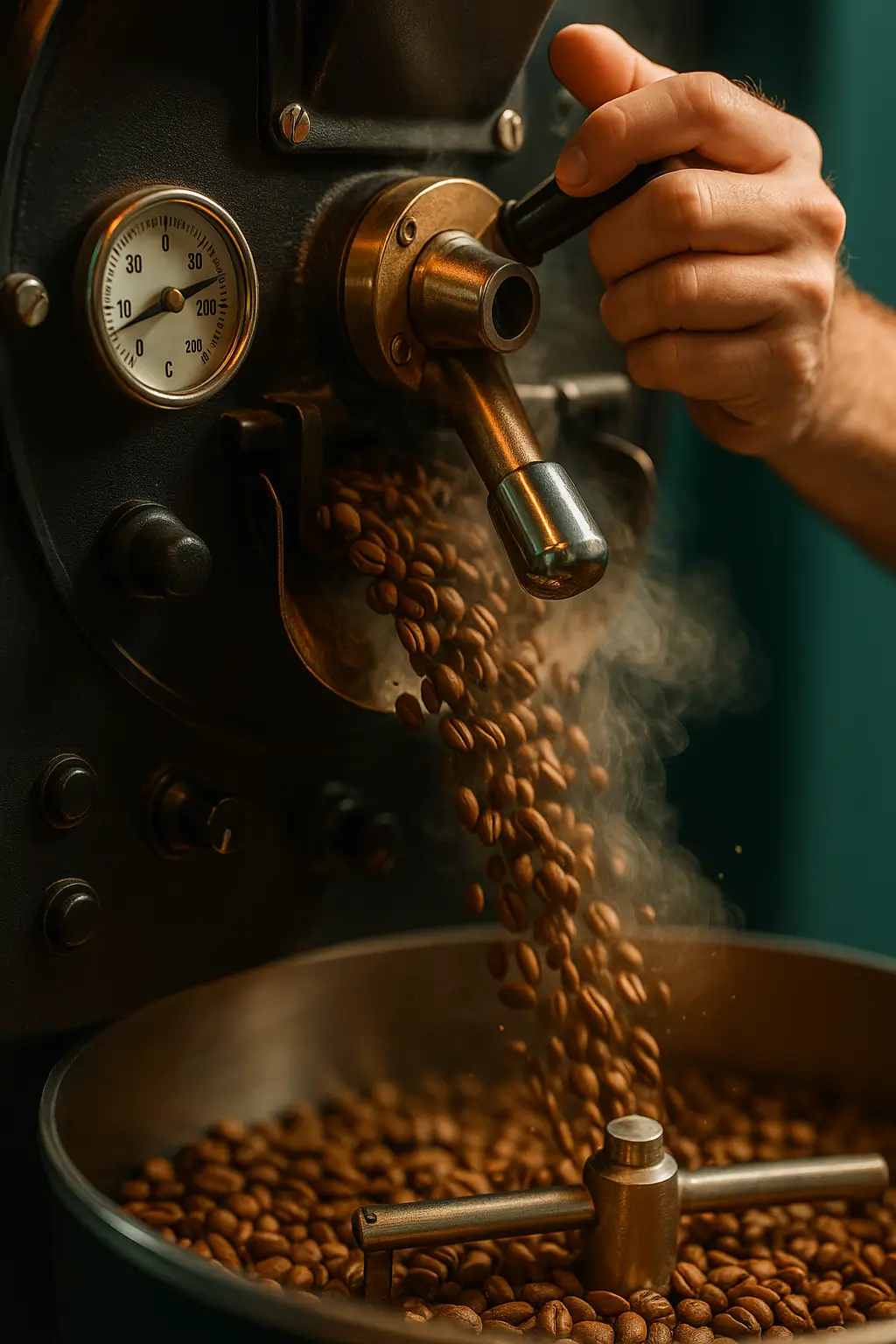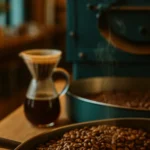A humble seed transforms into a beverage cherished by millions. It’s the science of coffee roasting. This complex process turns dull, herbaceous green coffee beans into fragrant, richly flavored coffee roasted beans. Roasting is more than just heating beans. It’s a precise chemical and physical change. Let’s explore this process, its key stages, and how different coffee roast profiles shape your daily cup.
What is the fundamental coffee roasting process?
Coffee roasting transforms green coffee beans into their aromatic, brewable state. You do it to develop coffee’s flavor, aroma, and color. This change happens by carefully controlling heat. Heat triggers chemical reactions, evaporates moisture, and expands the beans. The entire coffee roasting journey has three core stages:
- Drying,
- Roasting/browning,
- Cooling.
What happens during the drying stage of coffee roasting?
The drying stage removes moisture from the green coffee beans. These beans typically hold about 8-12% moisture. It must evaporate evenly. Roasters heat the beans inside a rotating drum. Temperatures reach 160-190°C (320-375°F) during this time. The beans change from green to a distinct yellow color, showing they’ve lost moisture. This stage is important. It prevents scorching and makes sure flavors develop evenly in later steps of the coffee roasting process.
What occurs during the roasting/browning stage in the science of coffee roasting?
The roasting/browning stage is the heart of the coffee roasting process. Here, major chemical and physical changes happen. Beans heat up to 150-230°C (300-450°F). Flavors develop, and the beans turn brown.
A key browning reaction, the Maillard Reaction, takes place. This complex chemical reaction happens between amino acids and reducing sugars inside the coffee bean. It creates hundreds of new flavor compounds and aroma compounds. These include melanoidins, which largely give coffee its smell and taste. Coffee then develops its rich profile.
Physical changes transform the beans at the same time. Beans expand a lot, almost doubling in size from internal pressure. The “First Crack” becomes audible. This signals the release of internal steam. The process also shifts from absorbing heat (endothermic) to releasing heat (exothermic) around 175°C.
After the First Crack, roasters move into the development/darkening phase. This phase greatly influences coffee acidity, sweetness, and body. This controlled time helps create various coffee roast profiles. For darker roasts, a “Second Crack” may happen. This means more cellular breakdown and increased bitterness.
Why is the cooling stage important for coffee roasting?
The cooling stage is vital right after roasting. It stops the process and preserves the complex flavors. Quick cooling keeps the beans from cooking further from their own heat. This prevents a ‘baked’ flavor or over-roasting. Common methods include powerful air cooling, where ambient air blows over the beans, or quenching with cool air. This rapid action stabilizes the roasted coffee beans. It locks in their desired traits and ensures consistent quality for your brew.
How do coffee roast profiles influence flavor?
Coffee roast profiles define a coffee’s final characteristics. They act as a spectrum of flavors. These profiles, from light to dark, dictate many sensory traits:
- Color,
- Overall coffee flavor,
- Coffee acidity,
- Body,
- Coffee aroma.
Your chosen roast level directly impacts the chemical compounds inside the bean. This shapes your cup’s taste.
What defines a light roast in the science of coffee roasting?
A light roast means coffee beans roasted just after the first crack. They reach about 385-410°F (196-210°C). These beans are light brown. You won’t see oil on their surface. This shows minimal cellular breakdown. Light roasts keep much of the bean’s original flavor. They highlight its natural, origin-specific notes. They are known for their bright acidity and complex flavors. You might find delicate floral notes or vibrant fruity notes. Natural acids like Chlorogenic Acid, Citric Acid, and Malic Acid mostly remain. This gives light roasts their high acidity and lively taste. These roasts usually have a light body. They offer a clean, nuanced cup.
A light roast means coffee beans roasted just after the first crack. Light roast coffee reaches about 385-410°F (196-210°C). These beans are light brown. You won’t see oil on their surface. This shows minimal cellular breakdown. Light roasts keep much of the bean’s original flavor. They highlight its natural, origin-specific notes. They are known for their bright acidity and complex flavors. You might find delicate floral notes or vibrant fruity notes. Natural acids like Chlorogenic Acid, Citric Acid, and Malic Acid mostly remain. This gives light roasts their high acidity and lively taste. These roasts usually have a light body. They offer a clean, nuanced cup.
What makes a medium roast balanced in coffee roasting?
A medium roast typically cooks coffee beans to about 410-430°F (210-221°C). They have a medium brown color. This roast level is known for its balanced, smoother flavor. It mixes the bean’s natural taste with new caramelized notes. Medium roasts have moderate acidity and a fuller body than lighter roasts. This gives them a more rounded mouthfeel. You might taste pleasant fruity notes, comforting nutty notes, or rich chocolaty notes. This creates a widely appealing taste. A medium roast offers a versatile choice. It bridges delicate origin traits with bolder roasted flavors.
What characterizes a medium-dark roast in the science of coffee roasting?
A medium-dark roast describes coffee beans that are darker brown. They have a slightly oily surface. This roast reaches into the middle of the second crack. This means deeper caramelization and some acid breakdown. These beans have a fuller body and lower acidity than medium roasts. Flavors tend towards a bittersweet flavor. You might find spicy flavor, dark chocolate flavor, or notes of burnt sugar flavor. Medium-dark roasts offer a smooth, robust flavor. It holds up well with milk and sugar. Their richness and strength make them popular for espresso and French press. For example, Sumatran and Guatemalan varieties often taste best at this roast level.
What defines a dark roast in the science of coffee roasting?
For dark roast coffee, beans are cooked to 430–450°F (221–232°C) or more. These beans are very dark brown, almost black. They have a distinct oily, shiny surface. This happens as oils move outward. Dark roasts have a strong bitterness, very low acidity, and a dominant toasty flavor and smoky flavor. The intense roast significantly changes or covers the original bean flavors. This results in a robust aroma. During this long roasting, many natural acids break down. These include Chlorogenic Acid, Citric Acid, and Malic Acid. However, other acids increase. These are:
- Quinic Acid,
- Acetic Acid,
- Formic Acid,
- Lactic Acid,
- Glycolic Acid.
They increase due to heat breaking down carbohydrates and other compounds. Dark roast subtypes include Vienna, French, Italian, and Espresso Roasts. Each varies slightly in flavor strength and color.
| Roast Profile | Color | Temperature Range | Acidity | Body | Flavor Notes |
|---|---|---|---|---|---|
| Light Roast | Light brown, no oil | 385-410°F (196-210°C) | Bright, high | Light | Floral, fruity, original bean notes |
| Medium Roast | Medium brown, no oil | 410-430°F (210-221°C) | Moderate, balanced | Fuller | Fruity, nutty, chocolaty, caramelized |
| Medium-Dark Roast | Darker brown, slightly oily | After 2nd crack starts | Lower | Fuller | Bittersweet, spicy, dark chocolate, burnt sugar |
| Dark Roast | Very dark brown to black, oily | 430-450°F (221-232°C) or beyond | Very low | Dominant | Toasty, smoky, bitter |
What factors influence different coffee roast profiles?
Roasters create specific coffee roast profiles by carefully considering several key factors. These guide decisions on roast time, temperature, and overall development. These elements combine art and science of coffee roasting. They help maximize each bean’s flavor potential. Understanding these influences lets roasters shape the final taste.
How do bean origin and characteristics impact coffee roasting?
Bean origin and characteristics deeply impact the coffee roasting process. Where a bean comes from – its elevation and climate, like Ethiopian Yirgacheffe or Colombian Supremo – affects its density, moisture, and natural flavors. For example, dense beans from high elevations can usually absorb more heat initially without burning. Also, a bean’s physical traits—like hardness, moisture level, and screen size—change how well it takes heat during roasting. These properties determine the best starting temperature and how much heat to apply throughout the roast cycle. This helps achieve the desired profile without flaws.
What role do processing method and intended brewing play in coffee roasting?
The processing method used on coffee cherries greatly influences bean flavors. It also changes how they respond during coffee roasting. Washed, natural, and honey processes each add unique traits. Roasters must consider these when designing a profile. Also, the intended brewing method often influences the desired roast level and profile. For instance, you might prefer a medium-dark roast for espresso. This gives a rich body and robust flavor. But you might choose a lighter roast for pour-over brewing. This highlights delicate floral notes and bright coffee acidity.
Why is the roaster’s craft essential for the science of coffee roasting?
The roaster’s craft is essential because good coffee roasting demands deep knowledge, precision, and constant attention. Roasters precisely control the process. They balance time and roasting temperature to get specific taste results. They use tools like real-time data logging and temperature probes. This helps them track the roast accurately. This mix of data and experience allows skilled roasters to consistently produce the right coffee roast profiles. The craft ensures each batch of beans reaches its full flavor. It delivers the taste you want.
What does the science of coffee roasting reveal about your daily cup?
The science of coffee roasting shows an intricate journey. It turns a simple green coffee bean into a complex, perfectly roasted coffee bean. This change is a remarkable blend of chemistry, physics, and artistry. The coffee roasting process—from initial drying, to the flavor-developing Maillard Reaction, to precise cooling—creates the diverse world of coffee flavor and coffee aroma we love. Each distinct coffee roast profile—light, medium, medium-dark, and dark—offers a unique sensory experience. Heat and time carefully craft each one. We hope you appreciate the deep complexity and effort in every cup. Explore our freshly roasted coffees and find your favorite roast profile today!









